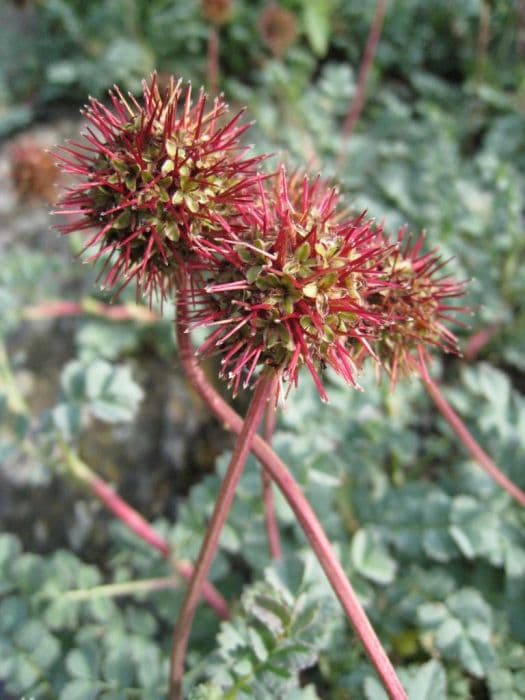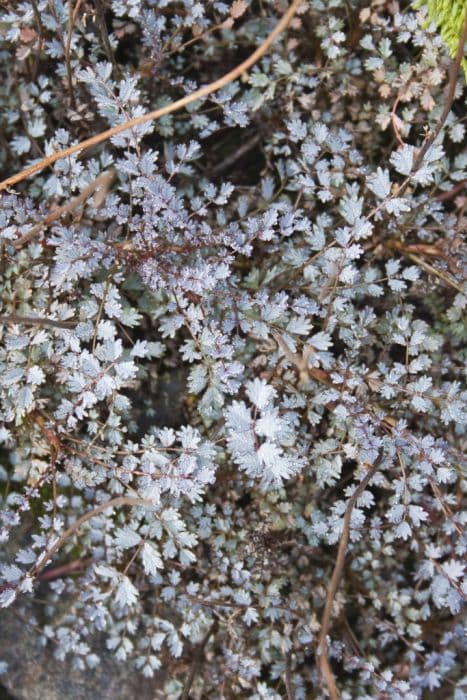Cherry Prunus 'Collingwood Ingram'

ABOUT
The plant known as 'Collingwood Ingram' is an ornamental cherry characterized by an array of stunning features that catch the eye, especially during its peak blooming season. It bears a burst of vibrant pink flowers, each comprised of multiple delicate petals that form a rounded shape, often likened to small bowls or cups. These blossoms are known for their captivating visual appeal and their ability to attract pollinators such as bees to the garden. The foliage of this plant is equally noteworthy, with leaves that emerge with a reddish hue before transitioning to a vivid green as the season progresses. In the fall, the leaves often change color once more, offering a splendid display of autumnal hues that range from golden yellow to rich bronze, adding a new dimension of beauty to the plant's profile. This variety stands out with its elegant branching structure, which is both robust and graceful, providing a sturdy framework for the plant's lush foliage and floral displays. The bark, too, adds to its ornamental value, with an attractive appearance that is appreciated during the winter months when the leaves have fallen, and the branches are bare. Overall, 'Collingwood Ingram' makes a striking addition to gardens and landscapes, bringing with it a sense of classic elegance and seasonal interest through its charming blooms, colorful leaves, and handsome structure.
About this plant
 Names
NamesSynonyms
Cherry 'Collingwood Ingram', Ornamental Cherry, Japanese Cherry.
Common names
Prunus 'Collingwood Ingram'.
 Toxicity
ToxicityTo humans
Cherry trees, which include the Prunus 'Collingwood Ingram', can be toxic to humans if ingested. The plant bears components that contain cyanogenic glycosides, primarily in the seeds, leaves, and stems. If parts of the plant containing these compounds are chewed and ingested, they can be metabolized into cyanide in the body. Symptoms of cyanide poisoning may include headache, dizziness, confusion, nausea, difficulty breathing, and potentially can lead to coma or death. However, the fruit flesh itself is typically not toxic and can be eaten, but caution should always be taken to avoid ingesting the seeds.
To pets
Cherry trees, the family to which the Prunus 'Collingwood Ingram' belongs, are also toxic to pets if they ingest the seeds, leaves, or stems. The toxicity is due to cyanogenic glycosides, which can release cyanide when metabolized. Signs of toxicity in pets can include salivation, restlessness, difficulty breathing, and dilated pupils. In severe cases, ingestion may lead to shock, respiratory failure, and even death. The fruit flesh is not generally considered toxic, but care should be taken to prevent pets from consuming any other part of the cherry tree.
 Characteristics
CharacteristicsLife cycle
Perennials
Foliage type
Deciduous
Color of leaves
Green
Flower color
Pink
Height
20 feet (6 meters)
Spread
20 feet (6 meters)
Plant type
Tree
Hardiness zones
5
Native area
Asia
Benefits
 General Benefits
General Benefits- Ornamental beauty - Prunus 'Collingwood Ingram', also known as Cherry 'Collingwood Ingram', produces stunning, showy pink blossoms that enhance landscape aesthetics.
- Attracts wildlife - Bees and other pollinators are attracted to the flower's nectar, while birds enjoy the cherries.
- Seasonal Interest - Cherry 'Collingwood Ingram' offers spring flowers and sometimes striking autumn leaf colors, adding seasonal interest to gardens.
- Shade provider - Once mature, this cherry tree can provide a pleasant shade area during sunny days.
- Low maintenance - It generally requires minimal care once established, fitting well into low-maintenance landscapes.
- Drought tolerance - After establishment, it shows some tolerance to drought, reducing the need for frequent watering.
- Cultural symbol - Cherry blossoms are a symbol of spring and renewal, often celebrated in festivals and rituals.
 Medical Properties
Medical PropertiesThis plant is not used for medical purposes.
 Air-purifying Qualities
Air-purifying QualitiesThis plant is not specifically known for air purifying qualities.
 Other Uses
Other Uses- Cherry wood smoking chips: Wood from 'Collingwood Ingram' cherry can be used to create smoking chips for barbecuing, imparting a sweet and fruity smoke flavor to meats and vegetables.
- Woodturning and carving: The cherry wood can be used for woodturning projects to create decorative items such as bowls, vases, and pens due to its workability and rich color.
- Wildlife habitat: When planted in gardens or parks, this cherry tree can provide shelter and a source of food for birds and other wildlife species.
- Dye production: Bark and leaves from the 'Collingwood Ingram' cherry can be used to produce natural dyes for textiles, offering hues in the range of reds and purples.
- Photography subject: The beautiful blossoms of 'Collingwood Ingram' make it a favored subject for photographers, particularly in spring when the flowers are in full bloom.
- Landscape design: Its distinctive form and beautiful spring blossoms make it a focal point in landscape design, especially in Japanese-style gardens.
- Culinary decorations: Although not typically used for consumption, the blossoms can provide a decorative touch for plating and serving special dishes during the spring season.
- Educational tool: The cherry tree can be used in educational settings to teach students about plant biology, phenology, and the changing seasons.
- Bonsai cultivation: Some enthusiasts use 'Collingwood Ingram' cherry to create bonsai trees, an art form that involves carefully pruning and shaping the tree to create a miniature landscape.
- Artistic inspiration: This cherry tree often serves as inspiration for artists and craftspeople, who use its image in paintings, textiles, and other creative works.
Interesting Facts
 Feng Shui
Feng ShuiThe Cherry Blossom is often used in Feng Shui to bring new beginnings, renewal, and the positive energy of growth, especially when placed in the East sector of a garden or home for health or in the Southwest for relationship luck.
 Zodiac Sign Compitability
Zodiac Sign CompitabilityThe Cherry Blossom is not used in astrology practice.
 Plant Symbolism
Plant Symbolism- Renewal: As a cherry blossoms, the Prunus 'Collingwood Ingram' symbolizes new beginnings and renewal, much like the onset of spring which is often marked by these flowers blooming.
- Impermanence: The fleeting beauty of the cherry blossoms conveys the transient nature of life, reminding us to appreciate the present.
- Feminine beauty: Cherry blossoms are often associated with soft, delicate, and pure beauty that is tied to feminine qualities.
- Love: In some cultures, cherry blossoms represent love and affection, often signifying romantic feelings or the beauty of love.
- Strength: Despite their delicate appearance, cherry blossoms are resilient, symbolizing the strength and endurance needed to face life's challenges.
 Water
WaterThe Japanese flowering cherry, commonly known as the Cherry 'Collingwood Ingram', should be watered deeply to encourage root growth, making sure that the soil is moist but not soggy. Newly planted trees require watering twice a week, giving about 10 to 15 gallons each time, depending on soil type and weather conditions. Once established, reduce watering to once a week or less, monitoring the soil moisture level. During the growing season, especially in dry spells, ensure consistent watering, but be careful not to overwater as this can lead to root rot.
 Light
LightThe Cherry 'Collingwood Ingram' flourishes in full sun to partial shade, with a preference for at least six hours of direct sunlight daily. The ideal spot for this tree would be an area that receives morning sun and some afternoon shade, protecting it from the intense heat of late day.
 Temperature
TemperatureCherry 'Collingwood Ingram' prefers temperate climates and can generally withstand temperatures down to around 0°F and up to around 100°F. The ideal growing conditions for this tree are between 50°F and 75°F. Proper mulching and site selection can help to mitigate extreme temperature fluctuations.
 Pruning
PruningPrune Cherry 'Collingwood Ingram' to remove dead or diseased wood and to shape the tree, enhancing its natural form. The best time to prune is in late winter or early spring before new growth starts. Thin out crowded branches every few years, and remove any suckers that arise from the base.
 Cleaning
CleaningAs needed
 Soil
SoilThe best soil mix for the flowering cherry, which is the common name of Prunus 'Collingwood Ingram', should be well-draining and fertile, with a mix of loam, organic matter, and sand to facilitate proper drainage. This flowering cherry prefers a slightly acidic to neutral pH, ranging from 6.0 to 7.5.
 Repotting
RepottingFlowering cherries like Prunus 'Collingwood Ingram' are typically planted outdoors and do not require repotting. However, if grown in a container, repotting should be done every 2-3 years to refresh the soil and accommodate root growth.
 Humidity & Misting
Humidity & MistingFlowering cherries, such as Prunus 'Collingwood Ingram', are adaptable to a wide range of outdoor humidity levels and do not require specific humidity conditions when planted in the garden.
 Suitable locations
Suitable locationsIndoor
Not recommended for indoor growth; needs sun, space.
Outdoor
Plant in full sun, well-draining soil, water regularly.
Hardiness zone
5-8 USDA
 Life cycle
Life cycleCherry 'Collingwood Ingram', often referred to as flowering cherry, begins its life as a seed, which germinates when conditions are suitable—usually in spring following a period of stratification that simulates winter. The seed develops into a seedling with a taproot and cotyledons, and as it grows, true leaves develop along with a woody stem; this is the sapling stage. As the sapling matures over several years, it enters the juvenile phase, establishing more significant branches and increasing in height and girth. Upon reaching maturity, the flowering cherry produces its striking pink blossoms each spring, followed by fruit set if pollinators such as bees have been present. After flowering, the tree enters a period of vegetative growth where leaves expand and photosynthesize to provide energy for the next flowering cycle. This cycle repeats annually, and with proper care, Cherry 'Collingwood Ingram' can live for several decades, going through continuous cycles of dormancy in winter and growth in the warmer months.
 Propogation
PropogationPropogation time
Spring-Early Summer
The Prunus 'Collingwood Ingram', commonly known as the 'Cherry' plant, is most effectively propagated through the method of softwood cuttings. This method is primarily done in late spring to early summer when the plant's new growth is still soft and flexible. To propagate using this method, a 4 to 6 inch cutting (about 10 to 15 centimeters) is taken from a healthy branch, ideally with several sets of leaves. The lower leaves are removed, and the cut end is often dipped in rooting hormone to encourage root development. The prepared cutting is then placed in a well-draining soil mix, ensuring at least two sets of leaf nodes are below the surface. The environment is kept humid, often with the help of a plastic cover, and the soil is kept moist but not waterlogged. Roots typically develop within a few weeks, after which the new plants can be gradually acclimatized to less humid conditions before being planted out.









